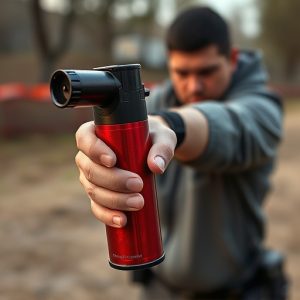Riot Control Tools: Safeguarding Kids, Understanding Pepper Spray
Proper storage of pepper spray is crucial to prevent accidental exposure and misuse, especially in h…….
Proper storage of pepper spray is crucial to prevent accidental exposure and misuse, especially in households with children. It should be securely stored in locked cabinets or high shelves, clearly labeled, and segregated from other products. Choosing a child-resistant dispenser with larger capacity, precise aiming, safety features, and durability ensures effective riot control while minimizing risks to kids. Rigorous legal protocols govern the use and storage of pepper spray, emphasizing responsible handling and public safety. Safer alternatives like non-lethal weapons and dispute resolution training are explored to promote child safety and reduce irritant usage in public settings.
“In the realm of public safety, effective riot control tools are essential, particularly when facing inflammatory situations. One such device under scrutiny is the pepper spray dispenser. This article delves into ‘Understanding Pepper Spray: A Tool for Riot Control’ while exploring the critical aspect of safe storage, especially away from children. We’ll guide you through the key features to consider in these dispensers and outline legal guidelines for responsible usage. Additionally, we’ll examine alternatives and their role in fostering child-safe environments.”
- Understanding Pepper Spray: A Tool for Riot Control
- The Risks of Inadequate Storage: Keeping Children Safe
- Features to Consider in a Riot Control Spray Dispenser
- Legal and Safety Guidelines for Usage and Storage
- Alternatives and Considerations for Child-Safe Environments
Understanding Pepper Spray: A Tool for Riot Control
Pepper spray, a powerful tool in riot control, has become an integral part of law enforcement and security strategies worldwide. This non-lethal chemical agent is designed to incapacitate individuals temporarily, providing critical time for authorities to restore order during chaotic situations like protests or civil unrest. The active ingredient, capsaicin, is derived from chili peppers, making it a natural yet potent irritant that affects the eyes, nose, and respiratory system.
Proper storage of pepper spray is essential, especially with children in the household. It should be kept out of reach, labeled clearly, and stored away from other household products to prevent accidental exposure or misuse. This simple measure can significantly reduce risks associated with this powerful tool, ensuring it remains effective when needed most during riot control scenarios.
The Risks of Inadequate Storage: Keeping Children Safe
Inadequate storage of riot control sprays, especially pepper spray, poses significant risks, particularly when children are involved. Keeping such potent chemicals within reach or in unsecured areas can have dangerous consequences, as curious kids might accidentally trigger the devices, leading to severe injury or panic. It is imperative that these products be stored securely and out of children’s sight and reach.
Proper Pepper Spray Storage Away From Children involves implementing simple yet effective measures. Using locked cabinets or high shelves ensures that only authorized adults can access the sprays. Additionally, labeling and child-proofing are crucial to prevent accidental discharges. By adhering to these safety protocols, you contribute to a safer environment, minimizing potential hazards and protecting the well-being of children.
Features to Consider in a Riot Control Spray Dispenser
When selecting a riot control spray dispenser, several key features should be top of mind. Firstly, consider the capacity and duration of the pepper spray; a larger reservoir ensures longer protection during high-intensity situations. Secondly, look for dispensers with precise aiming mechanisms to ensure accurate deployment, minimizing off-target effects and reducing collateral damage.
Safety is paramount, especially in public spaces. Therefore, riot control spray dispensers should have child-resistant features, like secure caps or complex triggers, to prevent accidental activation by children. Additionally, the design should be robust and durable, built to withstand rough handling and extreme environmental conditions without leaking or failing.
Legal and Safety Guidelines for Usage and Storage
When it comes to using and storing inflammatory riot control spray dispensers, it’s crucial to adhere to strict legal and safety guidelines. These protocols are in place to ensure public safety and prevent misuse. Pepper spray, a common active ingredient, requires special handling due to its potential for causing harm if not used responsibly. It is imperative that individuals and organizations using such devices store them securely, keeping them away from children and pets at all times. Improper storage can lead to accidental discharge or unauthorized access, which could result in serious consequences.
Legal regulations dictate specific requirements for the proper use of riot control spray, including permissible scenarios, application techniques, and distance restrictions. Authorities have established these rules to safeguard individuals from excessive force and ensure that pepper spray is employed only as a last resort during lawful gatherings or civil disturbances. Proper training and understanding of these guidelines are essential for anyone entrusted with carrying and deploying such devices.
Alternatives and Considerations for Child-Safe Environments
In the pursuit of maintaining public safety, especially in child-centric environments like schools, parks, and shopping malls, it’s crucial to explore alternatives to traditional riot control sprays that are safer for children. While pepper spray is often used for crowd control due to its swift impact, its storage and usage around minors require careful consideration. A primary concern revolves around preventing accidental exposure and ingestion by curious or vulnerable children. Therefore, a critical strategy involves storing these irritants securely away from reach, much like keeping toxic household products in high cabinets with child-proof locks.
Alternative solutions include non-lethal weapons that employ different mechanisms of irritation, such as tear gas canisters or specialized noise makers designed to disperse crowds without causing physical harm. Moreover, training and education play a significant role; teaching both adults and children about peaceful dispute resolution methods and de-escalation tactics can reduce the need for such irritants altogether. This multifaceted approach not only ensures child safety but also promotes a culture of peace and understanding in public spaces.
In conclusion, while pepper spray can be a valuable tool in riot control, it’s crucial to prioritize safety by storing it securely away from children. By understanding the risks, considering key features, adhering to legal guidelines, and exploring alternatives, we can ensure these powerful tools are used responsibly and effectively, fostering safer communities for all.


